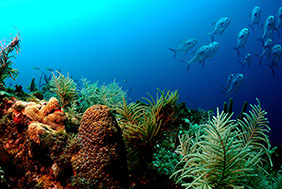-
Home
-
Data & Publications
-
Regional Portals
- About Regional Portals
- Florida
- Navassa Island
- Puerto Rico
- Flower Garden Banks
- U.S. Virgin Islands
- American Samoa
- Commonwealth of the Northern Mariana Islands
- Federated States of Micronesia
- Guam
- Main Hawaiian Islands
- Republic of the Marshall Islands
- Northwestern Hawaiian Islands
- Republic of Palau
- Pacific Remote Island Areas
-
CRCP Activities
- Glossary
A Review of the 2014-2017 Global Coral Bleaching Event
In 2014, NOAA Coral Reef Watch wrote about the prospect for a 2014-2015 El Niņo which, while not fully formed, helped start a three-year global coral bleaching event. The 2014-2017 global coral bleaching event was the third ever documented and is currently on record as the longest, most widespread, and most damaging bleaching event. It affected more coral reefs than any previous global bleaching event. In some coral reef areas, including reefs that had never bleached before, heat stress was the highest ever recorded, lasted for many months, and caused mass bleaching reef-wide.
Coral bleaching is a stress response to events such as changing ocean temperatures, pollution, and overexposure to sunlight. Corals expel their algae, called zooxanthellae, leading to the white color associated with bleaching. Bleached coral are not dead and can regain zooxanthellae if the stressor is reduced quickly. However, bleached coral are more vulnerable to additional stress and death.
Learn more about the 2014-2017 global bleaching event, and NOAA Coral Reef Watch's work to predict, remotely monitor in near real-time, document, and communicate with stakeholders about this devastating event, in the following story map: A Review of the 2014-2017 Global Coral Bleaching Event.


